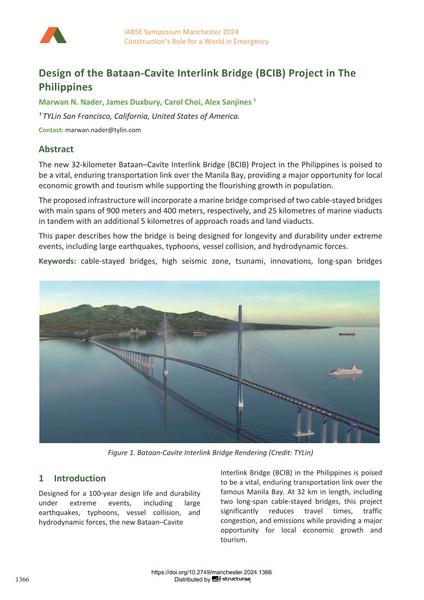Design of the Bataan-Cavite Interlink Bridge (BCIB) Project in The Philippines

|
|
|||||||||||
Détails bibliographiques
| Auteur(s): |
Marwan N. Nader
(TYLin San Francisco, California, United States of America.)
James Duxbury (TYLin San Francisco, California, United States of America.) Carol Choi (TYLin San Francisco, California, United States of America.) Alex Sanjines (TYLin San Francisco, California, United States of America.) |
||||
|---|---|---|---|---|---|
| Médium: | papier de conférence | ||||
| Langue(s): | anglais | ||||
| Conférence: | IABSE Symposium: Construction’s Role for a World in Emergency, Manchester, United Kingdom, 10-14 April 2024 | ||||
| Publié dans: | IABSE Symposium Manchester 2024 | ||||
|
|||||
| Page(s): | 1366-1374 | ||||
| Nombre total de pages (du PDF): | 9 | ||||
| DOI: | 10.2749/manchester.2024.1366 | ||||
| Abstrait: |
The new 32-kilometer Bataan–Cavite Interlink Bridge (BCIB) Project in the Philippines is poised to be a vital, enduring transportation link over the Manila Bay, providing a major opportunity for local economic growth and tourism while supporting the flourishing growth in population. The proposed infrastructure will incorporate a marine bridge comprised of two cable-stayed bridges with main spans of 900 meters and 400 meters, respectively, and 25 kilometres of marine viaducts in tandem with an additional 5 kilometres of approach roads and land viaducts. This paper describes how the bridge is being designed for longevity and durability under extreme events, including large earthquakes, typhoons, vessel collision, and hydrodynamic forces. |
||||
| Mots-clé: |
Ponts à haubans innovations
|
||||
